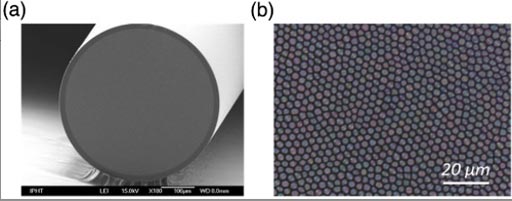Fiberoptic Probe Aids Endoscope Cancer Diagnosis
By MedImaging International staff writers
Posted on 22 May 2017
A compact fiber optic probe uses multiple nonlinear imaging techniques to identify cancer without the need for tissue staining, according to a new study.Posted on 22 May 2017
Developed by researchers at the Leibniz Institute of Photonic Technology, and Friedrich-Schiller University, the new multimodal probe is based on a gradient index (GRIN) lens design and a multi-core fiber supplying the excitation laser light. The probe enables the simultaneous recording of several nonlinear imaging modalities for biomedical applications, such as coherent anti-stokes Raman scattering (CARS), second harmonic generation (SHG), and two-photon excited auto-fluorescence (TPEF).

Image: A scanning electron micrograph (SEM) of the imaging fiber (a), and at X100 magnification (b) (Photo courtesy of IPTH).
Compared to traditional complex spherical lenses, GRIN lenses can be miniaturized to less than two mm because they focus light through constant refractive index changes within the lens material itself. With no moving parts or electric power required, the multi-core fiber can preserve the spatial relationship between entrance and output, allowing the ultrafast laser scanning procedure to be shifted from the distal to the proximal end of the probe. The generated signals can be collected and transferred to a detection setup in the probe head. The study describing the new probe was published in the May 2017 issue of Optica.
“Compared to other endoscopic nonlinear imaging approaches, our fiber probe stands out due to its simplicity. Since no moving parts are incorporated in the probe head, possible misalignments in the optics are limited and the probe’s overall lifetime is increased,” said lead author Professor Jürgen Popp, PhD, scientific director of IPTH. “We hope that, one day, multimodal endoscopic imaging techniques could help doctors make quick decisions during surgery, without the need for taking biopsies, using staining treatments, or performing complex histopathological procedures.”
GRIN lenses are generally used to collimate or reimage the output of a fiber. Typical applications include coupling the output of diode lasers into fibers, focusing laser light onto a detector, or collimating laser light. GRIN lenses do not require an air gap to function since the operation of the lens is due to varying indices in the lens itself, rather than the difference in indices between the air and lens. Additionally, in a GRIN lens, all optical paths are the same due to the radially varying refractive index, in contrast to a spherical or aspheric lens.








 Guided Devices.jpg)




